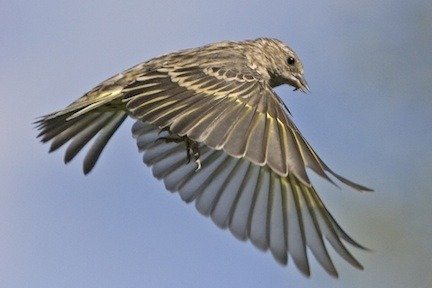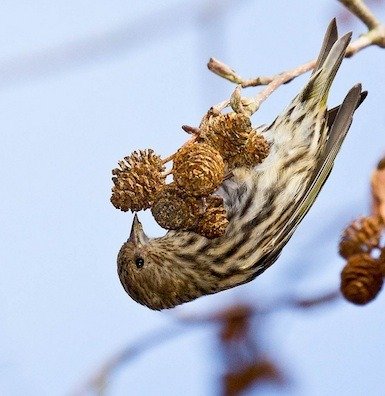





Nomadic members of the finch family, pine siskins are common cold weather visitors to gardens and back yards. But because these small songbirds determine a winter flight path based on seed availability, they may be plentiful at your feeder one year and absent the next.
Habitat and Range
The pine siskin (Spinus pinus) prefers open woodlands of conifers, or a mix of coniferous and deciduous trees, but will also take advantage of a variety of seeds to be found in weed fields, thickets, meadows, grasslands and backyard gardens.
During their breeding period, pine siskins are widespread across the northern parts of North America and the mountainous west. This bird’s winter range is much more erratic, with unpredictable movements, called irruptions, occurring every couple of years. At these times, flocks numbering in the thousands move into southern and eastern North America, potential visitors to each of the contiguous states. These mass movements are most likely triggered by fluctuations in food supply. Appearance
Appearance
Unlike most other finches, this bird's bill is slender, sharp and pointed. The pine siskin bears streaked brown feathers, with yellow edges on the wings and tail. It can also be identified by its short, notched tail and sharply pointed wingtips, which are most noticeable when it's in flight. Like its cousin, the goldfinch, the pine siskin soars in an undulating pattern.
Food
True to its name, the pine siskin is especially fond of seeds from pines and other conifers, such as spruce, cedar and hemlock. They also enjoy seeds of deciduous trees like maple, alder and birch, as well as buds from willows and elms. These opportunistic feeders will also take advantage of grass, dandelion, sunflower and ragweed seeds. Although their diet is primarily made up of seeds, they are also known to eat insects and spiders. Attracted to sources of mineral deposits, they are sometimes lured to the roadside by salt used for melting snow.
Behavior
These birds are often spied clinging upside down from a conifer branch, devouring seeds from the cones. Gregarious in habit, pine siskins forage together in large groups, keeping up an incessant wheezy chatter with their flockmates even when in flight.
siskins forage together in large groups, keeping up an incessant wheezy chatter with their flockmates even when in flight.
Mating and Nesting
The male pine siskin puts on a display for the female by flying in a circle with wings spread wide, all the while singing. During courtship, the female solicits feeding from the male by crouching and softly fluttering her wings.
The pair's nest, largely built by the female, is a shallow cup made of grasses, twigs and leaves, lined with soft bits of fur, feathers, moss or thistledown. The preferred nesting location is midway up a conifer, sited on the end of a horizontal branch. After the female lays three to five brown-speckled, pale green-blue eggs, the male continues to feed her throughout the brooding period.These birds are even social in their egg-laying habits, often nesting in neighboring trees.
Attracting to Your Yard
Pine siskins will readily visit backyard feeders, where they prefer small seeds without tough shells, like nyger or hulled sunflowers. They sometimes even forage alongside species with heavier beaks, so they can pick up bits of large seeds they can’t otherwise crack themselves.
Photo Credits:
Thumbnail photo by Thomas Quine
Pine siskin in flight by Bryan Jones
Pine siskin on conifer by Tom Talbott
Copyright © www.100flowers.win Botanic Garden All Rights Reserved